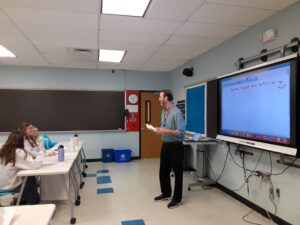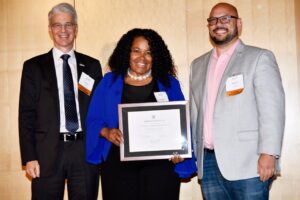 Latin teacher Ryan Scott has been teaching at Briarcliff High School since 2001. During this time, his Latin students have won more than 100 gold medals and more than 150 silver medals when taking the National Latin Exams.
Latin teacher Ryan Scott has been teaching at Briarcliff High School since 2001. During this time, his Latin students have won more than 100 gold medals and more than 150 silver medals when taking the National Latin Exams.
Mr. Scott, who also teaches Mandarin, acknowledges that although these languages might be less popular than French and Spanish, they offer many advantages to students who study them in high school.
He teaches four classes of Latin: Latin 1, 2, 3 and AP Latin.
He began studying the language as a sophomore in high school.
“In English class we read Shakespeare’s Julius Cesar and I really loved it, so I took Latin and it helped me so much with all of my other classes,” he said “It helped increase vocabulary in English class, because I was able to figure out the roots of the words. It also helped me in history class, because so much of western history is about the history of Rome. More importantly, it helped me to organize my thinking.”
Since Latin is not a spoken language, classwork is focused mainly on translating.
According to Mr. Scott, when you translate, you take certain steps in a certain order, similarly to solving math problems using order of operation.
“When you continuously do something with orders of operation, you can transfer that skill to anything,” Mr. Scott said. “For example, people who play certain online games like Wordle use steps and that can change the way your brain works.”
Mr. Scott said that Latin can help with all other subjects at school.
“In Latin class we study the Trojan War, and in English class students read the Odyssey, so it helps to know the background,” he said. “It also helps in history class when students learn about Rome. In biology class, a lot of the terminology is in Latin and in chemistry, two-thirds of the periodic table is in either Latin or Greek. In math class, almost all of the mathematic terms come from Latin.”
Students who study Latin at Briarcliff also participate in fun activities.
“I bring in an authentic toga for students to try on,” Mr. Scott said. “I used to have a replica of a Roman armor suit with metal plates that were held together by leather straps. They eventually wore out, and it costs just as much to repair as to buy a new one, so I am hoping to one day get a new suit of armor for the class.”
Mr. Scott thinks that in some ways studying Latin can be easier than studying Spanish or French.
“There is no need to practice speaking, since it’s not a spoken language,” he said. “And after you learn Latin, Spanish and French and other languages become easier because many of the vocabulary words cone from Latin.”
He would like to encourage students to study Latin at the high school.
“Aside from the years during the pandemic, we have been taking the National Latin Exam each year and have been winning consistently,” he said. “We have a great program here, at Briarcliff. The students and the district itself are wonderful.”
Mr. Scott also teaches one class of Mandarin at the school, which includes three levels.
“It’s not easy to teach three different levels all at once, but a lot of the language is cumulative, so if you are on level one, you will be using words that are on the same level as two or three,” he said. “We have a good software program that goes from level one to level four and students can move forwards and backwards with it. Plus, it enables students to hear native Mandarin speakers.”
Mr. Scott thinks that Mandarin is a good language for high school students to learn for several reasons.
“I think Mandarin is a beautiful language,” he said. “So much of it is just memorization, and the word order is similar to English; the grammar is not incredibly complicated like in Spanish or French. Speaking Mandarin often uses the same word order as English, unlike other languages, and you don’t need to change the verbs to conjugate them – they don’t change. Those things make it easier to learn.”
The language does come with its own set of challenges.
“There are four different tones and the way that you pronounce a word changes the meaning of it,” he said. “The other hard part is the number of characters that you need to learn – in order to be literate in Mandarin you need to know between 2,000 to 3,000 characters. When you combine characters, they have a different meaning than the individual characters. But it’s not a question of how many characters you know, it’s more a question of how many words you know. We have technology that makes it much easier to learn and is very helpful. For example, there’s an app where you draw a character and it tells you what it means.”
Mr. Scott thinks Mandarin is a very useful language.
“It is the most spoken native language in the world,” he said. “And China has the second strongest economy in the world, after the United States, so Mandarin would be helpful for students interested in going to business school.”
Regardless of which language students choose to study, Mr. Scott said they are in good hands at Briarcliff schools.
“The administration is very supportive of the language program,” he said. “I feel very lucky to work here.”







